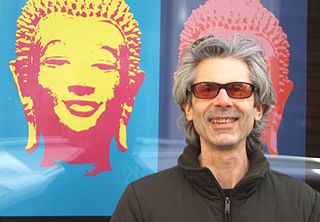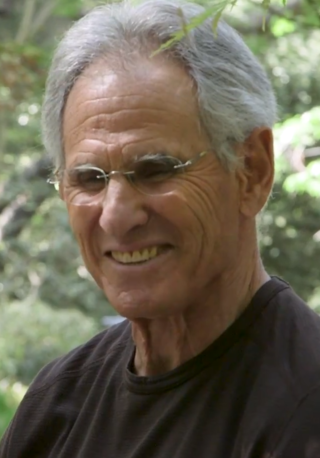
Mark Epstein is an American author and psychotherapist who integrates Shakyamuni Buddha's teachings with Sigmund Freud's approaches to trauma. He often writes about the interface of Buddhism and psychotherapy.
Mindfulness is the cognitive skill, usually developed through meditation, of sustaining meta-attention towards the contents of one's own mind in the present moment. Mindfulness derives from sati, a significant element of Hindu and Buddhist traditions, and is based on Zen, Vipassanā, and Tibetan meditation techniques. Though definitions and techniques of mindfulness are wide-ranging, Buddhist traditions describe what constitutes mindfulness, such as how perceptions of the past, present and future arise and cease as momentary sense-impressions and mental phenomena. Individuals who have contributed to the popularity of mindfulness in the modern Western context include Thích Nhất Hạnh, Joseph Goldstein, Herbert Benson, Jon Kabat-Zinn, and Richard J. Davidson.
A Jewish Buddhist is a person with a Jewish background who believes in the tenets of a form of Buddhism.

Jon Kabat-Zinn is an American professor emeritus of medicine and the creator of the Stress Reduction Clinic and the Center for Mindfulness in Medicine, Health Care, and Society at the University of Massachusetts Medical School. Kabat-Zinn was a student of Zen Buddhist teachers such as Philip Kapleau, Thich Nhat Hanh, and Seung Sahn, and a founding member of Cambridge Zen Center. His practice of hatha yoga, Vipassanā and appreciation of the teachings of Soto Zen and Advaita Vedanta led him to integrate their teachings with scientific findings. He teaches mindfulness, which he says can help people cope with stress, anxiety, pain, and illness. The stress reduction program created by Kabat-Zinn, mindfulness-based stress reduction (MBSR), is offered by medical centers, hospitals, and health maintenance organizations, and is described in his book Full Catastrophe Living.
Mindfulness-based cognitive therapy (MBCT) is an approach to psychotherapy that uses cognitive behavioral therapy (CBT) methods in conjunction with mindfulness meditative practices and similar psychological strategies. The origins to its conception and creation can be traced back to the traditional approaches from East Asian formative and functional medicine, philosophy and spirituality, birthed from the basic underlying tenets from classical Taoist, Buddhist and Traditional Chinese medical texts, doctrine and teachings.

Calmness is the mental state of peace of mind, being free from agitation, excitement, or disturbance. It also refers being in a state of serenity, tranquillity, or peace. Calmness can most easily occur for the average person during a state of relaxation, but it can also be found during much more alert and aware states. Some people find that focusing the mind on something external, such as studying, or internal, such as breathing, can be very calming.

Buddhism includes an analysis of human psychology, emotion, cognition, behavior and motivation along with therapeutic practices. Buddhist psychology is embedded within the greater Buddhist ethical and philosophical system, and its psychological terminology is colored by ethical overtones. Buddhist psychology has two therapeutic goals: the healthy and virtuous life of a householder and the ultimate goal of nirvana, the total cessation of dissatisfaction and suffering (dukkha).
Eastern philosophy in clinical psychology refers to the influence of Eastern philosophies on the practice of clinical psychology.
Choiceless awareness is posited in philosophy, psychology, and spirituality to be the state of unpremeditated, complete awareness of the present without preference, effort, or compulsion. The term was popularized in mid-20th century by Indian philosopher Jiddu Krishnamurti; the concept is a central theme in his philosophy. Similar or related concepts had been previously developed in several religious or spiritual traditions. The term, or others like it, has also been used to describe traditional and contemporary meditation practices, both secular and religious. By the early 21st century,choiceless awareness as a concept or term had appeared in a variety of fields, including neuroscience, therapy, and sociology, as well as in art. However, Krishnamurti's approach to the subject was unique, and differs from both prior and later notions.
Mindfulness-Based Stress Reduction (MBSR) is an eight-week, evidence-based program designed to provide secular, intensive mindfulness training to help individuals manage stress, anxiety, depression, and pain. MBSR was developed in the late 1970s by Jon Kabat-Zinn at the University of Massachusetts Medical Center. It incorporates a blend of mindfulness meditation, body awareness, yoga, and the exploration of patterns of behavior, thinking, feeling, and action. Mindfulness can be understood as the non-judgmental acceptance and investigation of present experience, including body sensations, internal mental states, thoughts, emotions, impulses and memories, in order to reduce suffering or distress and to increase well-being. Mindfulness meditation is a method by which attention skills are cultivated, emotional regulation is developed, and rumination and worry are significantly reduced. During the past decades, mindfulness meditation has been the subject of more controlled clinical research, which suggests its potential beneficial effects for mental health, athletic performance, as well as physical health. While MBSR has its roots in wisdom teachings of Zen Buddhism, Hatha Yoga, Vipassana and Advaita Vedanta, the program itself is secular. The MBSR program is described in detail in Kabat-Zinn's 1990 book Full Catastrophe Living.

Meditation and its effect on brain activity and the central nervous system became a focus of collaborative research in neuroscience, psychology and neurobiology during the latter half of the 20th century. Research on meditation sought to define and characterize various practices. The effects of meditation on the brain can be broken up into two categories: state changes and trait changes, respectively alterations in brain activities during the act of meditating and changes that are the outcome of long-term practice.

Mindfulness has been defined in modern psychological terms as "paying attention to relevant aspects of experience in a nonjudgmental manner", and maintaining attention on present moment experience with an attitude of openness and acceptance. Meditation is a platform used to achieve mindfulness. Both practices, mindfulness and meditation, have been "directly inspired from the Buddhist tradition" and have been widely promoted by Jon Kabat-Zinn. Mindfulness meditation has been shown to have a positive impact on several psychiatric problems such as depression and therefore has formed the basis of mindfulness programs such as mindfulness-based cognitive therapy, mindfulness-based stress reduction and mindfulness-based pain management. The applications of mindfulness meditation are well established, however the mechanisms that underlie this practice are yet to be fully understood. Many tests and studies on soldiers with PTSD have shown tremendous positive results in decreasing stress levels and being able to cope with problems of the past, paving the way for more tests and studies to normalize and accept mindful based meditation and research, not only for soldiers with PTSD, but numerous mental inabilities or disabilities.
The self-transforming brain refers to the ability of the self to consciously use mental activity to change/modify the brain's neural network in order to experience life with more happiness and fulfillment. This capacity of using awareness to do so is based on the assumption that the brain and the mind are closely connected, that one does not change without the other. The phrase "I think therefore I am" is not only a famous proclamation in the eyes of neuroscience. It has been evidenced that mental activities such as fleeting thoughts and feelings can create new neural structures in the brain and thus shape a person's reality. Therefore, it is possible to make use of the brain's neuroplasticity to re-wire or change one's brain and life by consciously activating happy, tranquil and loving mental states.
Mindfulness and technology is a movement in research and design, that encourages the user to become aware of the present moment, rather than losing oneself in a technological device. This field encompasses multidisciplinary participation between design, psychology, computer science, and religion. Mindfulness stems from Buddhist meditation practices and refers to the awareness that arises through paying attention on purpose in the present moment, and in a non-judgmental mindset. In the field of Human-Computer Interaction, research is being done on Techno-spirituality — the study of how technology can facilitate feelings of awe, wonder, transcendence, and mindfulness and on Slow design, which facilitates self-reflection. The excessive use of personal devices, such as smartphones and laptops, can lead to the deterioration of mental and physical health. This area focuses on redesigning and creating technology to improve the wellbeing of its users.

Mindful Yoga or Mindfulness Yoga combines Buddhist-style mindfulness practice with yoga as exercise to provide a means of exercise that is also meditative and useful for reducing stress. Buddhism and Hinduism have since ancient times shared many aspects of philosophy and practice including mindfulness, understanding the suffering caused by an erroneous view of reality, and using concentrated and meditative states to address such suffering.

BreathworksCIC is an international mindfulness organization founded in the United Kingdom, which offers mindfulness-based approaches to living well with pain, stress, and illness. It is known particularly for developing the approach of mindfulness-based pain management (MBPM), which shares many elements with mindfulness-based stress reduction (MBSR) but is adapted specifically for those living with chronic pain and illness, and incorporates a distinctive emphasis on the practice of 'loving-kindness'. Breathworks is a registered Community Interest Company (CIC) in the United Kingdom, and has nearly 500 accredited teachers working in 35 countries.

Prudence Margaret Burch, known professionally as Vidyamala Burch, is a mindfulness teacher, writer, and co-founder of Breathworks, an international mindfulness organization known particularly for developing mindfulness-based pain management (MBPM). The British Pain Society has recognized her "outstanding contribution to the alleviation of pain", and in 2019, 2020, 2021 and 2022 she was named on the Shaw Trust Power 100 list of the most influential disabled people in the UK. Burch's book Mindfulness for Health won the British Medical Association's 2014 Medical Books Award in the Popular Medicine category.

Full Catastrophe Living: Using the Wisdom of Your Body and Mind to Face Stress, Pain, and Illness is a book by Jon Kabat-Zinn, first published in 1990, revised in 2013, which describes the mindfulness-based stress reduction (MBSR) program developed at the University of Massachusetts Medical Center's Stress Reduction Clinic. In addition to describing the content and background of MBSR, Kabat-Zinn describes scientific research showing the medical benefits of mindfulness-based interventions (MBIs), and lays out an approach to mind-body medicine emphasizing the depth of the interconnections between physical and mental health. The book has been called "one of the great classics of mind/body medicine", and has been seen as a landmark in the development of the secular mindfulness movement in the United States and internationally.
Willem Kuyken is a British/Dutch scientist, teacher and author. He is the Ritblat Professor of Mindfulness and Psychological Science at the University of Oxford, United Kingdom, and Director of the University of Oxford Mindfulness Centre.
Christiane Wolf [pronounced "kri-stii-aa-ne"] is a German-American author, speaker and teacher of mindfulness, compassion and stress reduction. With her medical background, Wolf is known for her specialty in working with people who suffer from chronic illness and pain. Wolf is an authorized Buddhist teacher in the Insight (Vipassana) meditation tradition and teaches classes and retreats worldwide.










